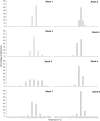Crossing latitudes--long-distance tracking of an apex predator
- PMID: 25671609
- PMCID: PMC4324986
- DOI: 10.1371/journal.pone.0116916
Crossing latitudes--long-distance tracking of an apex predator
Abstract
Tiger sharks (Galeocerdo cuvier) are apex predators occurring in most tropical and warm temperate marine ecosystems, but we know relatively little of their patterns of residency and movement over large spatial and temporal scales. We deployed satellite tags on eleven tiger sharks off the north-western coast of Western Australia and used the Brownian Bridge kernel method to calculate home ranges and analyse movement behaviour. One individual recorded one of the largest geographical ranges of movement ever reported for the species, travelling over 4000 km during 517 days of monitoring. Tags on the remainder of the sharks reported for shorter periods (7-191 days). Most of these sharks had restricted movements and long-term (30-188 days) residency in coastal waters in the vicinity of the area where they were tagged. Core home range areas of sharks varied greatly from 1166.9 to 634,944 km2. Tiger sharks spent most of their time in water temperatures between 23°-26°C but experienced temperatures ranging from 6°C to 33°C. One shark displayed seasonal movements among three distinct home range cores spread along most of the coast of Western Australia and generalized linear models showed that this individual had different patterns of temperature and depth occupancy in each region of the coast, with the highest probability of residency occurring in the shallowest areas of the coast with water temperatures above 23°C. These results suggest that tiger sharks can migrate over very large distances and across latitudes ranging from tropical to the cool temperate waters. Such extensive long-term movements may be a key element influencing the connectivity of populations within and among ocean basins.
Conflict of interest statement
Figures







Similar articles
-
Residency and movement patterns of an apex predatory shark (Galeocerdo cuvier) at the Galapagos Marine Reserve.PLoS One. 2017 Aug 22;12(8):e0183669. doi: 10.1371/journal.pone.0183669. eCollection 2017. PLoS One. 2017. PMID: 28829820 Free PMC article.
-
A matter of taste: Spatial and ontogenetic variations on the trophic ecology of the tiger shark at the Galapagos Marine Reserve.PLoS One. 2019 Sep 20;14(9):e0222754. doi: 10.1371/journal.pone.0222754. eCollection 2019. PLoS One. 2019. PMID: 31539419 Free PMC article.
-
Reef-fidelity and migration of tiger sharks, Galeocerdo cuvier, across the Coral Sea.PLoS One. 2014 Jan 8;9(1):e83249. doi: 10.1371/journal.pone.0083249. eCollection 2014. PLoS One. 2014. PMID: 24421879 Free PMC article.
-
Diet Composition and Trophic Ecology of Northeast Pacific Ocean Sharks.Adv Mar Biol. 2017;77:111-148. doi: 10.1016/bs.amb.2017.06.001. Epub 2017 Aug 18. Adv Mar Biol. 2017. PMID: 28882212 Review.
-
High microplastic and anthropogenic particle contamination in the gastrointestinal tracts of tiger sharks (Galeocerdo cuvier) caught in the western North Atlantic Ocean.Environ Pollut. 2024 Mar 1;344:123185. doi: 10.1016/j.envpol.2023.123185. Epub 2023 Dec 24. Environ Pollut. 2024. PMID: 38147950 Review.
Cited by
-
Retrospective genomics highlights changes in genetic composition of tiger sharks (Galeocerdo cuvier) and potential loss of a south-eastern Australia population.Sci Rep. 2022 Apr 21;12(1):6582. doi: 10.1038/s41598-022-10529-w. Sci Rep. 2022. PMID: 35449439 Free PMC article.
-
The trophic role of a large marine predator, the tiger shark Galeocerdo cuvier.Sci Rep. 2017 Aug 9;7(1):7641. doi: 10.1038/s41598-017-07751-2. Sci Rep. 2017. PMID: 28794497 Free PMC article.
-
Residency and movement patterns of an apex predatory shark (Galeocerdo cuvier) at the Galapagos Marine Reserve.PLoS One. 2017 Aug 22;12(8):e0183669. doi: 10.1371/journal.pone.0183669. eCollection 2017. PLoS One. 2017. PMID: 28829820 Free PMC article.
-
Population structure and connectivity of tiger sharks (Galeocerdo cuvier) across the Indo-Pacific Ocean basin.R Soc Open Sci. 2017 Jul 5;4(7):170309. doi: 10.1098/rsos.170309. eCollection 2017 Jul. R Soc Open Sci. 2017. PMID: 28791159 Free PMC article.
-
A matter of taste: Spatial and ontogenetic variations on the trophic ecology of the tiger shark at the Galapagos Marine Reserve.PLoS One. 2019 Sep 20;14(9):e0222754. doi: 10.1371/journal.pone.0222754. eCollection 2019. PLoS One. 2019. PMID: 31539419 Free PMC article.
References
-
- Sydeman WJ, Brodeur RD, Grimes CB, Bychkov AS, McKinnell S (2006) Marine habitat “hotspots” and their use by migratory species and top predators in the North Pacific Ocean: Introduction. Deep Sea Res Part II Top Stud Oceanogr 53: 247–249.
-
- Beschta RL, Ripple WJ (2009) Large predators and trophic cascades in terrestrial ecosystems of the western United States. Biol Conserv 142: 2401–2414.
-
- Jackson JB, Kirby MX, Berger WH, Bjorndal KA, Botsford LW, et al. (2001) Historical overfishing and the recent collapse of coastal ecosystems. Science 293: 629–637. - PubMed
Publication types
MeSH terms
Substances
LinkOut - more resources
Full Text Sources
Other Literature Sources
Miscellaneous

